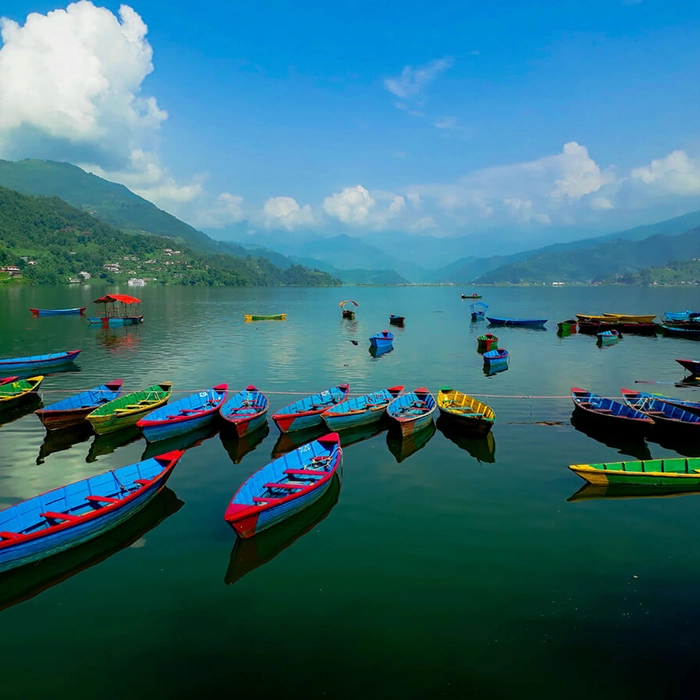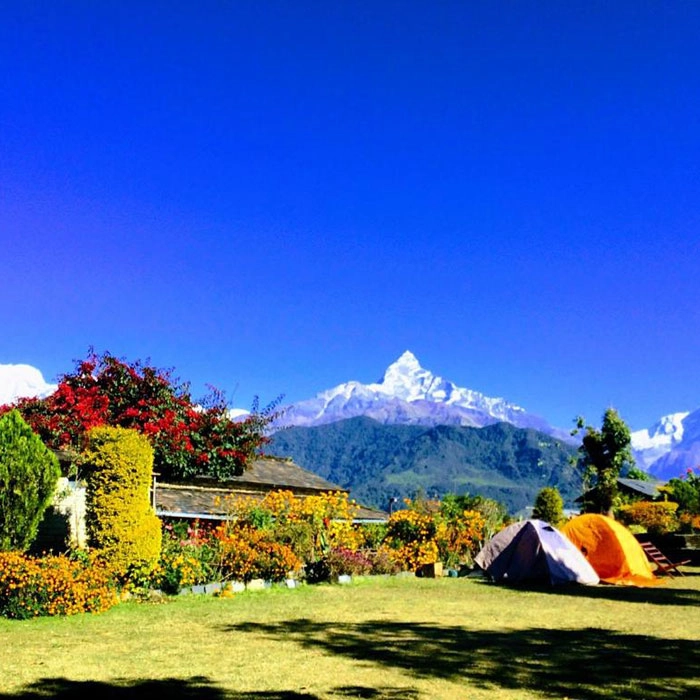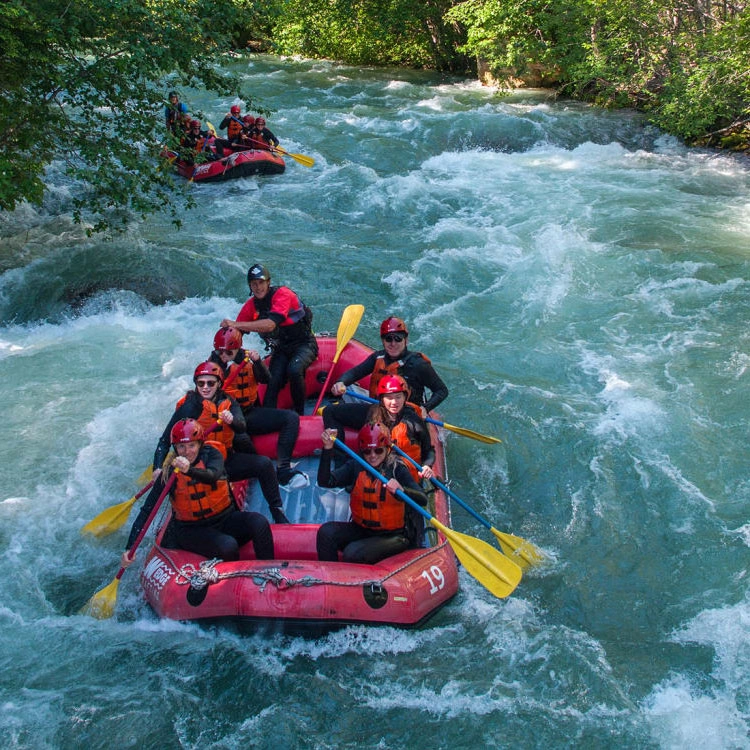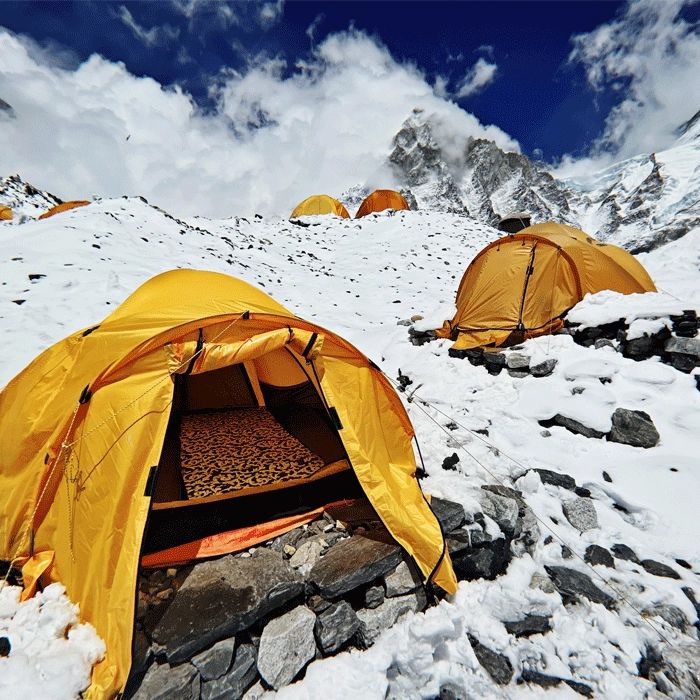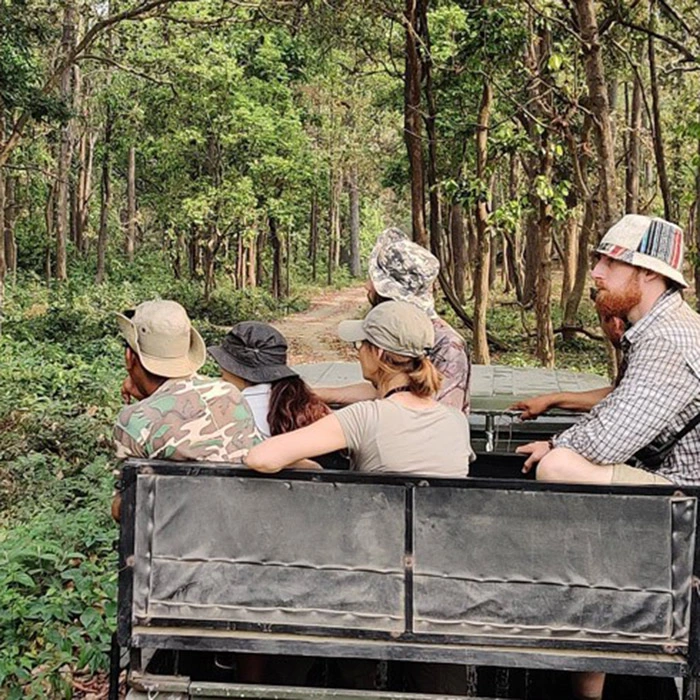AMA DABLAM BASE CAMP TREK
US$2,250.00
/pp
-
15 Days
-
Everest
-
Spring/Autumn
-
Trekking
-
4,600 Meters
-
Moderate
-
Car / Plane
-
01-16 People
-
JH#226
 Overviews
Overviews
The Ama Dablam Base Camp trek is ideal for all ages and beginners. Your adventure starts in Kathmandu, the capital of Nepal, where you can explore the city during your free time before your trek. From Kathmandu, we either fly or drive to Phaplu. From there, we follow the classic Everest Base Camp route, passing through Namche Bazaar and Tengboche Monastery. After Tengboche, we veer off the main trail towards Pangboche and ultimately reach Ama Dablam Base Camp at 4,600 meters. Trekking HighlightsAs you trek in this Ama Dablam Base Camp Trek, you’ll encounter several cultural and natural highlights that make the experience memorable. Visit ancient monasteries, such as the renowned Tengboche Monastery, where you can soak in the spiritual atmosphere and admire stunning views of Ama Dablam. You’ll also have the opportunity to interact with local Sherpa communities, learning about their traditions and way of life. The landscape transforms dramatically as you ascend, shifting from lush green forests to alpine meadows, offering a visually captivating trekking experience. Best Time to Do Ama Dablam Base Camp Trek in NepalThe best time to hike to Ama Dablam Base Camp is in the spring (March to May) and fall (late September to November). These times of year have the most stable weather, clear skies, and mild temperatures, which are great for hiking and seeing the mountains. In the spring, rhododendrons and alpine flowers bloom. In the fall, the air is clear and crisp, and you can see the Himalayan peaks from all over the place. The monsoon season (June to August) brings heavy rain, slippery trails, and poor visibility. Winter trekking is colder and harder because of snow and ice. What Makes Ama Dablam Base Camp Trek Special?People often call Ama Dablam the "Matterhorn of the Himalayas" because its peak is so sharp, beautiful, and famous. The hike to its base camp gives hikers a chance to get really close to this beautiful mountain and see its high ridges and glaciers. The path goes through colorful Sherpa villages, Buddhist monasteries, and rhododendron forests, giving you a chance to see beautiful nature and learn about different cultures. During climbing seasons, the base camp is a busy place with great views of nearby giants like Mount Everest, Lhotse, and Nuptse. How Difficult is Ama Dablam Base Camp Trek?The hike is thought to be moderate to hard. It involves slowly climbing to a height of about 4,600 meters at base camp. The trail itself doesn't require any technical climbing skills, but the high altitude, rough terrain, and long days of walking can be hard on your body. To safely enjoy the trek, you need to get used to the weather and get in shape. Permits Required for Ama Dablam Base CampTo trek to Ama Dablam Base Camp, you will need: - Sagarmatha National Park Permit — required for hiking in this area.
- TIMS (Trekkers’ Information Management System) Card — required for everyone who goes trekking in Nepal.
Jagadamba Holidays takes care of these permits for you, so you won't have to worry about the paperwork. Safety and PrecautionsWhen hiking in high places and remote areas like Ama Dablam, safety is very important. Some important safety tips are to - Go on a trek with a licensed and experienced guide who knows the route and what to do in case of an emergency.
- Bring a first-aid kit that is well-stocked with medicine for headaches, altitude sickness, and other common illnesses.
- Wear layers of clothes to be ready for quick changes in the weather.
- Drink plenty of water and eat healthy foods to keep your energy up.
- Follow the rules of the area and don't stray from the marked paths.
- Watch for signs of altitude sickness and be ready to go down if they get worse.
- Tell your guide right away if you feel sick or tired.
Training and Preparation for Ama DablamGetting your body ready is the most important part of a successful trek. At least two to three months before the event, start training with an emphasis on cardiovascular fitness, endurance, and strength. Hiking with a heavy backpack, running, biking, and climbing stairs are all activities that can help you build the stamina you need. If you can, also practice hiking on different types of ground. It's also important to get your mind ready for the physical and environmental challenges you might face. Mountain ViewsThe views of the mountains from Ama Dablam Base Camp are some of the best in Nepal. The famous Ama Dablam peak stands out in the skyline with its high ridges and hanging glaciers. People who hike also get great views of Mount Everest, Lhotse, Nuptse, and Thamserku. The way the rough mountains look against the deep valleys and lush forests is unforgettable. Altitude Sickness and PreventionAltitude sickness can affect anyone trekking above 3,000 meters. Preventative measures include: - Go up slowly and give yourself time to get used to the new altitude.
- Drink a lot of water and don't drink alcohol.
- Eat a healthy diet and don't eat a lot of food right before bed.
- Be aware of early signs like headaches, dizziness, nausea, and tiredness.
- Talk to a doctor before you think about taking medicine like Diamox.
- If your symptoms get worse or worse quickly, go down.
What to Expect During Ama Dablam ClimbIf you want to climb Ama Dablam after the base camp, be ready for a very technical and difficult trip. To climb, you need to be an expert mountaineer, have the right gear, and get used to the altitude at several camps higher up the mountain. Climbers have to deal with steep ice and rock faces, crevasses, and weather that can change at any time. Most trekkers, on the other hand, go on the base camp trek, which is a great adventure that shows off Sherpa culture and the Himalayas. Unique Trekking ExperienceAma Dablam Base Camp Trek offers a diverse experience in the Everest region, culminating in a quieter route to Ama Dablam Base Camp. Fewer trekkers choose this path, making it a unique journey. The trek is also beginner-friendly, featuring manageable daily hikes and moderate altitude gains, ensuring comfort for those new to high-altitude trekking. Along the way, you’ll enjoy breathtaking views of majestic peaks, lush valleys, and the rich culture of the Sherpa people, enhancing the journey’s appeal. Why Choose Jagadamba Holidays to Trek Ama DablamIf you're thinking of doing the Ama Dablam Base Camp trek, Jagadamba Holidays can help you with everything you need. - We take care of all the permits and logistics.
- Hire experienced Sherpa guides who know the area well
- Make sure that you have comfortable places to stay and eat along the way.
- Your safety, acclimatization, and a real trekking experience are our top priorities.
- We want you to enjoy every step in the shadows of these great peaks so we provide personalized best quality service that very few other travel agencies can provide.
Things You Should KnowThere isn't much internet or cell phone service along the trail. Most lodges have electricity, but you might have to pay a small fee to charge your devices. There are only ATMs in Lukla and Namche Bazaar, so make sure you have enough cash. The weather can change quickly, so be ready. Also, be respectful of local customs, especially at holy places and monasteries. Is Ama Dablam Base Camp Trek for Me?This trek is good for people who are moderately fit and are okay with walking for several days at high altitudes. It also has a lot of interesting mountain culture and beautiful scenery. It's perfect for adventurers who want to experience a mix of challenge and culture without having to do any technical climbing (unless they want to continue on a climbing expedition). This trek might be hard for you if you like luxury or don't want to work out. Extend Your HolidayWhen you book your Nepal holiday, you can easily add extra days to explore additional destinations that suit your interests. After receiving your trip booking, we will contact you to discuss any extra services or experiences you might want for your extended trip. If additional payments are needed for these services, we will inform you in advance to ensure a smooth planning process. Whether you wish to unwind in a tranquil setting or embark on another adventure, we’re here to help you make the most of your time in Nepal. MealsLocal lodges serve meals during the trek. They usually have a mix of Nepali and Tibetan foods, like dal bhat, momos, noodles, soups, and simple Western foods like pasta and eggs. There are a lot of vegetarian options. The food is fresh and filling, which gives you the energy you need for long days of hiking. AccommodationThere are tea houses and lodges that offer simple, clean rooms with twin beds, shared bathrooms, and places to eat together. As you go down, the facilities get better, but at higher altitudes, you should expect basic comfort with blankets. It is best to bring a sleeping bag to stay warm. Enduring MemoriesThe Ama Dablam Base Camp Trek is a transformative experience that transcends mere physical challenge. It offers a chance to immerse yourself in nature and disconnect from the pressures of daily life. As you journey through this breathtaking landscape, you will not only witness the grandeur of the Himalayas but also cultivate a deeper appreciation for the environment and the rich culture of the Sherpa people. With its unique blend of adventure, culture, and stunning vistas, this trek promises unforgettable memories that will stay with you long after you return home. Plan Your Ama Dablam ClimbJagadamba Holidays handles all the details, like getting you to and from the airport, getting you permits, hiring experienced guides, porters, places to stay, and meals. We make sure that our itineraries include enough acclimatization days to make sure that the trek is safe and fun. We tailor your trip to fit your goals and level of fitness, whether you want to go on the base camp trek or the full climbing expedition. So contact us now to book this amazing trek and experience it firsthand. Why Choose Ama Dablam Base Camp TrekThe Ama Dablam Base Camp Trek is a way to get to one of the most famous peaks in the world and have a unique cultural experience in the Khumbu region. It has a beautiful mix of nature, Sherpa hospitality, and mountain fun. If you choose this trek, you'll get to see the heart of the Himalayas up close while being safe and supported by experienced professionals. Packing List, Gears, and EquipmentFor a successful Ama Dablam base camp trek, pack the following essentials: - Base layers and thermal underwear
- Trekking shirts and quick-dry pants
- Insulating fleece jacket and down jacket
- Waterproof and windproof shell jacket and pants
- Warm hat, gloves, and buff or scarf
- Sturdy trekking boots (well broken-in) and camp shoes
- Sleeping bag rated for –10°C or lower
- Trekking poles for stability
- Backpack (40–50L) and daypack (20L)
- Headlamp with extra batteries
- Sunglasses with UV protection
- Sunscreen and lip balm
- Water bottles and water purification tablets
- Personal first-aid kit including altitude sickness medication
- Power bank and chargers
- Toiletries and quick-dry towel
Ama Dablam Base Camp Trek CostThe Ama Dablam Base Camp Trek cost typically includes essential services such as a licensed trekking guide, porter support, necessary permits (including Sagarmatha National Park entry and TIMS card), teahouse or camping accommodations, all meals during the trek, and ground transportation to and from the trailhead. Solo trekkers benefit from personalized attention and support, while groups can enjoy tiered discounts that reduce per-person cost as group size increases. We also offer seasonal promotions during quieter trekking seasons to enhance affordability. Although our website lists standard international pricing, you can contact us directly for private group booking rates, ensuring the most competitive price without compromising on high-quality service, safety, and comfort throughout this unforgettable journey.
 Itinerary (Plan)
Itinerary (Plan)
Arrive in Kathmandu, Nepal's vibrant capital, where you'll be warmly welcomed with marigold garlands. After transferring to your hotel, take time to relax and acclimate to the bustling city. Discover vibrant local markets, indulge in traditional Nepali dishes, and delve into Kathmandu's rich cultural tapestry. This initial day is perfect for easing into your journey, setting the stage for the exciting adventures ahead in Eastern Nepal. A representative from Jagadamba Holidays will ensure a smooth and pleasant arrival.
Optional Evening Activity:
If you wish, you can spend your evening experiencing the Pashupatinath Aarti, a captivating religious ceremony held at the Pashupatinath Temple. The Aarti usually begins around 6:00 PM and lasts for approximately an hour. This ceremony is a mesmerizing display of traditional music and rituals, providing a profound insight into Hindu spiritual practices. Please check the exact time for the Aarti on the day of your visit, as it may vary. This option is not included in the standard itinerary but offers a unique opportunity to immerse yourself in local culture.
After breakfast at the hotel, transfer to the domestic airport for a scenic morning flight to Phaplu (2,460 m / 8,071 ft.), the gateway to the Everest region. This picturesque flight offers sweeping views of the Himalayas, giving a glimpse of the remarkable landscapes that await. Phaplu serves as a key starting point for trekking adventures, allowing you to acclimatize gradually and experience the local Sherpa culture before heading further into the Khumbu region.
Note: Depending on the travel date, if there is no scheduled flight to Phaplu, we will travel by private 4WD jeep to Phaplu or as far as the road conditions allow. Your trekking itinerary will be adjusted accordingly by your lead guide.
Upon landing, begin your trek toward Ringmu (2,720 m / 8,924 ft.), a charming Sherpa village nestled in the foothills. The trek journey covers about 12 kilometers and takes approximately 4 to 5 hours. During this journey, you will ascend 620 meters and descend 300 meters.
As you make your way through pine and rhododendron forests, enjoy the serene natural beauty and occasional glimpses of snow-capped peaks in the distance. The trail is relatively easy, providing a comfortable introduction to trekking in the Solu region. You’ll pass through small hamlets, observing the lifestyle of local Sherpa communities.
Upon reaching Ringmu, settle into a cozy teahouse for the night. In the evening, you can explore the village or relax and enjoy a hearty meal, preparing for the longer trekking days ahead.
After breakfast at the lodge, embark on your trek to Jubhing (1,680 m / 5,512 ft.), passing through Taksindu La Pass (3,070 m / 10,072 ft.) and Nunthala (2,220 m / 7,283 ft.). The trek journey covers approximately 11 kilometers and takes around 6 hours. During this journey, you will ascend 410 meters and descend 1,560 meters.
The trail begins with a steady ascent toward the Taksindu La Pass, which offers breathtaking panoramic views of the surrounding valleys and distant peaks. On clear days, you may catch your first glimpse of Mount Everest. As you approach the pass, the beauty of the highlands and the surrounding ridges become more vivid, offering excellent photo opportunities. After crossing the pass, the trail descends through lush rhododendron forests, which bloom beautifully in the spring, adding vibrant color to the landscape.
After a brief stop in Nunthala, a popular rest point for trekkers, continue downhill through terraced farmlands and Sherpa villages, observing traditional lifestyles along the way. You’ll cross a suspension bridge over the Dudh Koshi River before reaching the serene village of Jubhing, your stop for the night. Jubhing is a peaceful village where you can immerse yourself in local culture, enjoy traditional Sherpa hospitality, and relax in a cozy teahouse, preparing for the next day’s trek.
After your breakfast at the lodge, embark on your trek from Jubhing to Paiya (2,730 m / 8,957 ft.), crossing the scenic Kari La Pass (2820m / 9,252 ft.). The trek journey covers about 12.5 kilometers and takes approximately 6 hours. During this journey, you will ascend roughly 1,390 meters and descend around 300 meters.
The trek from Jubhing to Paiya through Kari La Pass unfolds with a steady ascent through lush forests and scenic landscapes dotted with small villages. The trail leads through vibrant greenery and terraced fields, with views of distant peaks that provide a glimpse of the majestic Himalayas. As you trek, you’ll pass through remote settlements where the traditional lifestyle of the local people is evident. Here, farmers work in terraced fields that cascade down the hillsides, and you may encounter villagers going about their daily routines. The ascent to Kari La Pass is challenging but rewarding, with each step revealing new sights and breathtaking panoramas that invite you to pause and take in the natural beauty.
Upon reaching the top of Kari La Pass, the vista opens up to a stunning panorama, ideal for a well-earned rest and photographs to capture the experience. After crossing the pass, the trail begins a descent, winding through narrow forested paths that require careful footing, especially when conditions are wet. The path is often rocky and can be slippery, adding a bit of adventure to the journey. As you approach Paiya, the terrain gradually eases, leading to a gentle path into the village. This tranquil hamlet, surrounded by the serene mountain landscape, offers a peaceful atmosphere to unwind after a full day of trekking. With the quiet sounds of nature around, Paiya provides the perfect place to relax, reflect on the journey, and prepare for the next stage of your trek.
After breakfast at the lodge, embark on your trek to Phakding (2,610 m / 8,563 ft.), passing through Surke and Chheplung (2,660 m / 8,727 fr.). The journey covers approximately 15.5 kilometers and takes around 6 hours. Along the way, you will ascend 730 meters and descend 840 meters.
Leaving Paiya, the day’s trek begins with a descent through lush, dense forests, opening up to reveal the village of Surke nestled in the valley below. As you make your way down, enjoy the scenic landscapes, where traditional settlements offer glimpses of local culture, from terraced fields to village homes adorned with prayer flags. These communities, rich in Sherpa heritage, provide an authentic experience of mountain life in the Solu-Khumbu region.
After passing through Surke, a gentle ascent guides you to Cheplung, a picturesque stop where the views of surrounding peaks are particularly striking, showcasing the grandeur of the Himalayan range. From here, the trail continues through a blend of forested stretches and open landscapes. Occasional steep sections add variety to the trek, making each part of the journey engaging. Approaching Phakding, the path becomes more level and winds alongside the Dudh Koshi River, offering a tranquil riverside ambiance. Phakding, with its peaceful setting and comfortable lodges, serves as an inviting spot for the night, where you can rest and reflect on the day’s journey amidst the serene sounds of the river.
After your breakfast at the lodge, embark on your trek to Namche Bazaar (3,440 m / 11,286 ft.), traversing the scenic route through Monjo (2,835 m). The trek covers about 9.5 kilometers and takes approximately 5 to 6 hours. During this journey, you will ascend 860 meters and descend 190 meters.
We embark on a picturesque trek in the Khumbu region along the Dudh Koshi River. Here, we'll cross stunning suspension bridges adorned with colorful prayer flags. As we navigate the trail, we pass through charming Sherpa villages and lush rhododendron forests, steadily ascending while soaking in breathtaking views of majestic snow-capped peaks.
This journey offers both beauty and challenge, making every step worthwhile. Upon reaching Namche Bazaar (3,440 m / 11,286 ft.), the largest Sherpa village and a vital trading hub, we’ll have ample opportunity to acclimatize to the altitude.
Namche Bazaar's vibrant market is bustling with shops, cafes, and bakeries, creating a lively atmosphere against the dramatic Himalayan backdrop. After checking into our lodge, you can relax, hydrate, and enjoy a warm meal. In the evening, we’ll gather with our group to share stories and reflect on the day’s adventures, setting the stage for an exciting acclimatization day ahead.
This trek from Phakding to Namche Bazaar not only showcases stunning vistas but also immerses you in the rich Sherpa culture, making it a memorable part of your Everest Base Camp journey.
Make the most of your rest day in Namche Bazaar by acclimatizing to the altitude and immersing yourself in the stunning beauty of the Khumbu region. After a hearty breakfast, you can either explore the vibrant town of Namche or embark on an optional scenic trek to Khunde, passing through Khumjung village, with a stop at the renowned Everest View Hotel (3,880 m / 12,730 ft.).
This picturesque hike to Khunde offers breathtaking views of the world’s tallest peaks, including Mount Everest, Lhotse, and Ama Dablam. The well-marked trail is relatively steep, rewarding trekkers with panoramic vistas and ample opportunities for memorable photographs. At the Everest View Hotel, take a moment to pause for refreshments while soaking in the magnificent surroundings before continuing your journey to Khunde, a charming Sherpa village rich in culture and history.
Once in Khunde, explore local attractions such as the Sherpa museum and historic monasteries, which showcase the unique heritage of the Sherpa people. After your trek, return to Namche Bazaar for a leisurely lunch and some free time to visit local shops, purchase trekking gear, or unwind at a cozy café with stunning mountain views.
In the evening, gather with your group to share stories from your day and enjoy a warm meal together. This day of exploration and acclimatization not only enriches your experience in the Himalayas but also prepares you for the exciting adventures that lie ahead.
The round-trip trek from Namche Bazaar to Khunde via the Everest View Hotel and Khumjung covers approximately 8.15 kilometers and typically takes 5 to 6 hours. During the journey, you will ascend 550 meters and descend 550 meters.
After enjoying breakfast at the lodge, set out on your scenic trek to Phortse, navigating the breathtaking route through Mong La (3,975 m), known for its panoramic views of the majestic Himalayas. The trek covers about 10.5 kilometers and takes approximately 5 to 6 hours. During this journey, you will ascend 790 meters and descend 400 meters.
The journey to Phortse takes you on a scenic trek, crossing over Mong La (3,975 m / 13,041 ft.), a breathtaking viewpoint offering panoramic views of the Himalayas. As you climb higher, you’ll be rewarded with spectacular sights of Mount Ama Dablam, Thamserku, and Kangtega, along with distant peaks like Everest and Lhotse. The trail winds through dense rhododendron and juniper forests, which in spring bloom into a vibrant display of colors.
Upon reaching Mong La, the view becomes even more expansive, revealing stunning vistas of the Dudh Koshi River valley and snow-capped mountains all around. Take a moment to rest and capture photos of this awe-inspiring landscape. From Mong La, the path sharply descends into the lush valley of Phortse Tenga, followed by a steady ascent that leads you to the authentic Sherpa village of Phortse, known for its rich cultural heritage.
Phortse, located at an altitude of around 3,810 meters (12,500 ft.), is one of the lesser-frequented villages on the Everest trekking route, offering a more authentic glimpse into Sherpa culture. The terraced fields and traditional stone houses present a peaceful contrast to the more commercialized areas along the trail. As you approach Phortse, enjoy the views of Phortse Gompa, an ancient monastery perched above the village.
Upon arrival, settle into your lodge, where you can relax and soak in the tranquility of this remote mountain setting. In the evening, take a stroll through the village, meet locals, or simply unwind as you gaze out at the surrounding peaks, reflecting on the beauty and challenges of today’s trek. Today’s trek offers a remarkable experience, combining breathtaking mountain scenery with deep insights into the traditional Sherpa way of life, leaving you with lasting memories.
After breakfast at the lodge, embark on your trek to Ama Dablam Base Camp (4,600 m / 15,092 ft.), passing through Pangboche (3,985 m / 13,074 ft.). This trek covers approximately 10 kilometers and takes around 6 to 7 hours. During this journey, you will ascend 960 meters and descend 210 meters.
Leaving Phortse, the trail gently ascends, presenting breathtaking views of snow-capped peaks and deep, green valleys below. The path winds through forests of vibrant rhododendron and aromatic juniper, offering opportunities to spot Himalayan wildlife like the elusive tahr and musk deer, often seen grazing along the hillside. The journey to Pangboche, the oldest Sherpa village in the Khumbu region, is a cultural highlight, providing an authentic experience of local life. The village’s historic monastery, one of the oldest in the region, is a must-visit, offering a peaceful ambiance and insights into Sherpa spiritual traditions.
From Pangboche, the trek becomes steeper as you continue toward Ama Dablam Base Camp. The ascent, while challenging, rewards you with increasingly magnificent views of towering peaks, including the majestic Mount Ama Dablam, Everest, and Lhotse. Each step reveals a new vantage point, enhancing the grandeur of the surroundings. Reaching the base camp, you are welcomed by a dramatic panorama of towering mountains, icy glaciers, and rugged terrain that defines the high-altitude landscape. Here, surrounded by the imposing peaks, you’ll find a sense of awe and tranquility, providing an ideal setting to rest, reflect, and fully absorb the grandeur of the Himalayas.
After breakfast at the lodge, embark on your trek to Tengboche (3,860 m / 12,664 ft.), traversing the scenic route through Deboche (3,820 m). The trek covers about 8.5 kilometers and takes approximately 4 to 5 hours. During this journey, you will ascend 130 meters and descend 850 meters.
As you begin this section of the trek, the route offers breathtaking panoramic views of the Himalayas, showcasing the towering peaks of Ama Dablam, Mount Everest, Lhotse, and Nuptse. The trail leads through serene pine forests, winding past terraced fields and rhododendron-clad hillsides, adding to the natural beauty of the landscape. The quiet and tranquil atmosphere creates the perfect backdrop for a peaceful trekking experience.
Continuing your journey, you'll descend to the charming village of Deboche, where prayer flags flutter in the wind and ancient monasteries offer a glimpse into the region's deep-rooted Buddhist culture. From here, the trek ascends gently toward the renowned Tengboche Monastery, the spiritual heart of the Khumbu region. As you approach, the sight of the monastery framed against the backdrop of Everest and other majestic peaks is nothing short of awe-inspiring.
Upon reaching Tengboche, you’ll have the opportunity to explore the monastery, soak in the peaceful surroundings, and admire the intricate architecture and spiritual significance of this sacred place. As one of the most important monasteries in the region, Tengboche offers a serene space for reflection, making this day a truly memorable part of your Himalayan adventure with Jagadamba Holidays.
After breakfast at the lodge, embark on your trek to Monjo (2,835 m / 9,301 ft.), traversing the scenic route through Kyangjuma (3,600 m / 11,811 ft.). The trek covers about 15.5 kilometers and takes approximately 6 to 7 hours. During this journey, you will ascend 400 meters and descend 1,450 meters.
As you set out from Tengboche Monastery, the trail takes you through pristine forests of rhododendron and pine, offering breathtaking views of the surrounding snow-capped peaks. The tranquility of the mountains, combined with the vibrant prayer flags fluttering in the wind, creates a spiritual atmosphere that perfectly complements your journey. Along the trail, you will journey through the picturesque village of Kyangjuma, a spot renowned for its sweeping vistas of towering Himalayan giants like Ama Dablam, Everest, and Lhotse. The panoramic scenery here is truly captivating, offering an ideal pause for trekkers to soak in the grandeur of the surrounding peaks.
The descent towards Monjo leads you through scenic river valleys and over suspension bridges that cross the mighty Dudh Koshi River. You’ll encounter traditional Sherpa villages along the way, where the locals greet you with warm smiles and a glimpse into their unique culture. The landscape transitions from high alpine terrain to lush green valleys as you make your way down, showcasing the diversity of the region’s natural beauty.
Upon reaching Monjo, a peaceful village nestled in the Dudh Koshi Valley, you can relax and reflect on the day's journey. Monjo, located at the gateway to Sagarmatha National Park, provides a peaceful and relaxing atmosphere after a long day’s trek. Nestled in the tranquil Dudh Koshi Valley, it serves as a quiet retreat where you can unwind and reflect on the day’s adventures while surrounded by nature’s beauty. Take the time to unwind, appreciate the surrounding views, and prepare for the final stages of your Himalayan adventure.
After breakfast at the lodge, embark on your trek to Lukla (2,846 m / 9,350 ft.), traversing the scenic route through Phakding (2,610 m). The trek journey covers about 12.5 kilometers and takes approximately 4 to 5 hours. During this journey, you will ascend 410 meters and descend 330 meters.
As you set off from Monjo, the trail meanders alongside the rushing waters of the Dudh Koshi River, providing a soothing soundtrack to your adventure. The stunning scenery is adorned with colorful rhododendron forests, rich greenery, and quaint traditional villages, creating a vibrant tapestry that enhances your trekking experience. Watch for local wildlife along the way, such as vibrant birds and mischievous monkeys, as you traverse this captivating landscape.
The journey to Lukla offers more than just reaching your destination; it provides a chance to delve into the rich Sherpa culture that flourishes in this enchanting region. You may encounter friendly locals along the way, offering warm smiles and greetings that enhance your trekking experience. Take the time to appreciate the intricate carvings and prayer flags adorning the monasteries that line the path, which serve as a reminder of the spiritual significance of this region.
As you approach Lukla, the bustling atmosphere of this gateway town comes into view. Known for its famous airport, Lukla serves as the starting point for many trekkers heading into the Everest region. Upon arrival, enjoy a moment to relax and reflect on your journey while soaking in the views of the surrounding peaks.
This trek concludes with a sense of accomplishment and anticipation for the adventures that lie ahead in the majestic Himalayas. Whether you are an experienced trekker or a novice explorer, the journey from Monjo to Lukla through Nurning offers a memorable experience filled with breathtaking landscapes and cultural insights.
After an unforgettable journey through the breathtaking landscapes of the Everest region, it's time to conclude your adventure with a scenic return flight from Lukla to Kathmandu. This flight is not only a means of transportation but also an extension of your Himalayan experience, offering stunning aerial views that will leave you in awe.
As you board the small aircraft, the excitement builds for the final leg of your trek. The flight from Lukla, known for its challenging runway, will take you on a thrilling journey above the majestic mountains you’ve spent days trekking through. As the plane ascends, you'll be treated to panoramic views of the rugged Himalayan terrain, including towering peaks and deep valleys. On a clear day, you might catch glimpses of some of the world’s highest mountains, including Lhotse, Makalu, and, of course, the iconic Mount Everest.
The flight typically lasts about 30 to 40 minutes, providing ample time to soak in the breathtaking scenery. The pilot often maneuvers the plane in a way that allows passengers to see both sides, so be sure to have your camera ready. The vibrant colors of the landscapes below contrast beautifully with the stark whites of the snow-capped peaks, creating a stunning visual tapestry.
Upon arriving at Tribhuvan Domestic Airport, you will be welcomed back to the vibrant city of Kathmandu, where the lively atmosphere and rich culture await your exploration. The transition from the serene mountains to the vibrant energy of the capital is a reminder of the diverse experiences Nepal offers. After collecting your luggage and possibly sharing stories with fellow trekkers, you’ll have the opportunity to explore the rich cultural heritage, delicious cuisine, and lively markets of Kathmandu.
This return flight not only marks the end of your trek but also serves as a perfect conclusion to an adventure filled with breathtaking landscapes, cultural encounters, and personal reflections. Cherish the memories you’ve created in the heart of the Himalayas, as they will stay with you long after your journey concludes.
The buffer day in Kathmandu serves as a crucial safety net during your trekking adventure in the Himalayas. Given the unpredictable nature of mountain weather and the potential for flight delays, this day is designed to ensure a smooth travel experience. By including a buffer day in your itinerary, you can mitigate the impact of unforeseen circumstances and allow for a more relaxed journey.
If your flights operate as scheduled and weather conditions are favorable, this day offers a fantastic opportunity to explore the rich cultural and historical tapestry of the Kathmandu Valley. The valley is a UNESCO World Heritage Site, home to seven remarkable monument zones, each showcasing unique aspects of Nepalese culture and heritage.
You can begin your exploration in the heart of Kathmandu at Durbar Square, where ancient palaces, temples, and courtyards tell the story of the city's royal history. Marvel at the intricately carved architecture of Kastamandap and Kasthamandap Temple, and don’t miss the iconic Kumari Ghar, the residence of the living goddess, or Kumari.
Next, consider visiting Swayambhunath, also known as the Monkey Temple, perched atop a hill overlooking the valley. This ancient stupa is adorned with colorful prayer flags and offers panoramic views of the city and surrounding mountains. The site is also home to many monkeys, adding a playful element to your visit.
For a more spiritual experience, you can head to Boudhanath Stupa, one of the largest stupas in the world. This sacred site is a significant pilgrimage destination for Buddhists and features a bustling marketplace filled with traditional shops and eateries. Here, you can observe the rituals of local monks and engage with the community while enjoying a delicious bowl of traditional Nepali dal bhat.
If you have time, a trip to Pashupatinath Temple, one of the holiest Hindu temples in the world, is a must. Situated along the banks of the Bagmati River, this temple complex is a hub of religious activity, where you can witness traditional cremation ceremonies and explore the serene surroundings.
Throughout your day of exploration, immerse yourself in the vibrant local culture, indulge in delectable street food, and engage with the friendly locals. This buffer day not only acts as a precautionary measure for travel disruptions but also enhances your overall experience in Nepal, allowing you to discover the breathtaking beauty and rich history of the Kathmandu Valley. Whether your journey is uninterrupted or you need to utilize this day for adjustments, it promises to be a memorable addition to your adventure in the Himalayas.
Concluding Your Journey in Nepal
As your remarkable journey through the Himalayas comes to an end, take a moment to reflect on the awe-inspiring natural beauty, rich cultural heritage, and memorable experiences that have defined your time in Nepal. From the majestic mountain landscapes to the warm hospitality of the local communities, every moment has contributed to an unforgettable adventure.
Airport Transfer by Jagadamba Holidays
To ensure a smooth and timely departure, an official representative from Jagadamba Holidays will collect you from your hotel 3.5 hours prior to your scheduled flight departure. Our team is committed to providing a reliable and comfortable transfer service to Tribhuvan International Airport, allowing you to conclude your journey with peace of mind.
We sincerely appreciate your trust in Jagadamba Holidays and hope to have the pleasure of serving you again on your future journeys.
Quotation 2025
| Group Size (Pax) |
1 - 2 |
3 - 4 |
5 - 6 |
7 - 8 |
9 - 12 |
13 - 16 |
17 - 20 |
21 - 24 |
25 - 32 |
| Cost Per Person |
$2,025 |
$1,995 |
$1,965 |
$1,935 |
$1,905 |
$1,875 |
$1,845 |
$1,815 |
$1,785 |
 Cost Include
Cost Include
- All transfers within Nepal are included as per itinerary
- Any domestic flight of Nepal as per trekking itinerary
- Trekking accommodation (hotel, lodge and/or tent) as per itinerary
- Small shared room with shared bathroom during trek in Nepal
- In Kathmandu and/or Pokhara: Stay at ***Hotel with breakfast
- Luggage for porters during the trek (12.5 kg/person)
- Enjoy unlimited breakfast, lunch, and dinner throughout the trek.
- Unlimited tea or coffee for breakfast during the trek
- An English speaking guide (trekking/tour) as per Itinerary
- Travel insurance for trekking staff (guides and porters)
- All expenses of trekking staff(s) during trekking
- Includes all conservation, national park, trekking, and climbing permits
- Sightseeing / Wildlife tours if included in the itinerary
- Farewell dinner in Kathmandu before returning home
 Cost Exclude
Cost Exclude
- Single room/single tent surcharge (on request)
- Round trip/one way international flight ticket to Nepal.
- Tourist visa for Nepal (30-50 $, depending on length of stay)
- Personal Insurance (covers: Trip/flight cancellation, helicopter rescue)
- Meals (lunch, dinner) at hotels in Kathmandu, Pokhara and other cities
- Drinks (soft, hot or mineral/boiled water) during the lodge trek
- Any personal trekking and/climbing equipment for trekking in Nepal
- Hotel expenses in case of early return from trekking for any reason
- Costs due to flight cancellations & extra porters/horses during the trek
- Additional costs incurred due to any reason beyond Jagdamba’s control
- More evidence about pandemics like COVID-19 if needed in the future.
- Personal expenses during the trek (phone, wifi, shower, charging etc.)
- Other costs and things that are not mentioned in the service inclusion
- Gratuity for trekking staff (recommended: 9€ /10$ per traveler per day)
|







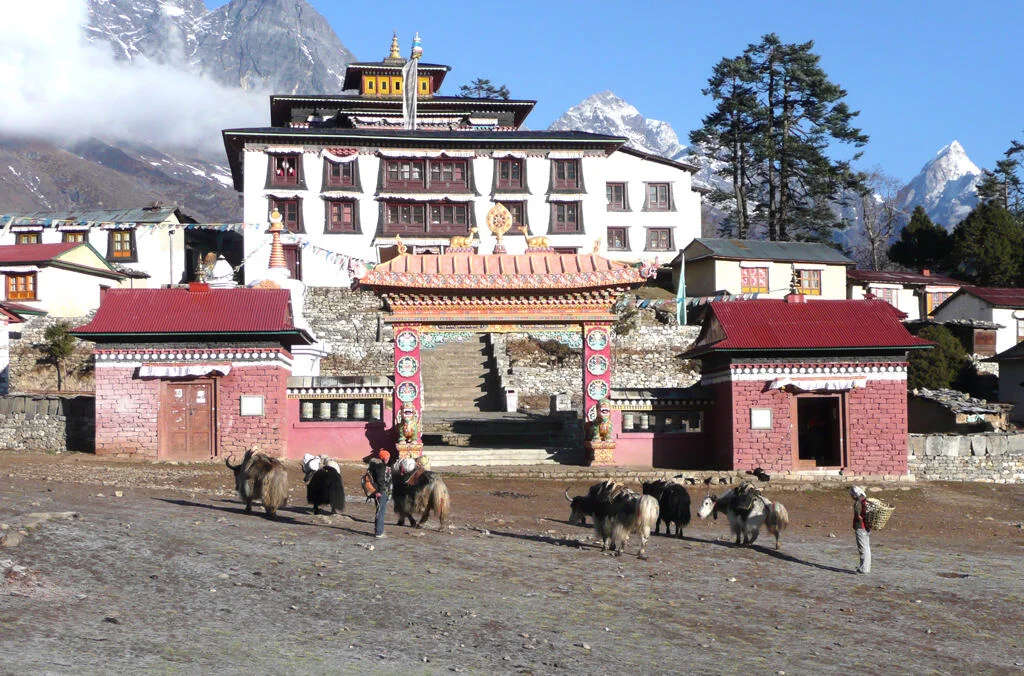











 Overviews
Overviews
 Trip Overview
Trip Overview
 Travel Itinerary
Travel Itinerary
 Cost Include
Cost Include
 Cost Exclude
Cost Exclude
 Fixed Departure
Fixed Departure
 Route Map
Route Map

 Freqeuntly Asked Questions
Freqeuntly Asked Questions
 Reviews And Rating
Reviews And Rating
